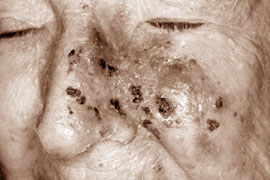|

Old age intimacy
by Nilma Dole
It was taboo to talk about sexual needs of older people, because
young people couldn’t bear to think of their grandparents as sexually
agile. This is a big myth because the next time you see your grandfather
holding your grandmother’s hand, be happy that they have a stable and
happy marriage instead of thinking it as being repulsive, Dr. Sudhakar
Krishnamurti said.
 |
|
Dr. Sudhakar
Krishnamurti |
Worldwide andrology and sex expert, Dr. Sudhakar Krishnamurti who
became the only Asian to be awarded the prestigious Herbert Newman award
in original clinical research in the field of sexual medicine believes
that our aversion to the idea that older people might enjoy and need sex
is linked to our preconceived notions that it is negative.
According to the Indian doctor who paid a visit to Sri Lanka
recently, it’s not plastic surgery or anti-ageing creams that would
maintain your youth after you’re 60 but sex. He said, recent research
reveals that sex is the secret ingredient for successful ageing.
A study on sexual relationships and sexual health among older people
suggests that not only does sex get better with age but older people who
have sex regularly save better physical and mental health than their
chaste counterparts.
In the Archives of Sexual Behaviour, it revealed that among healthy
80 to 102 year-olds, 63 percent of men and 30 percent of women were
still sexually active.
Some of the reasons why women could be less active is because with
menopause comes complications such as dryness of the vagina or physical
discomfort during sex. It could also mean that the woman could be ill in
other ways, or simply rather lacking in energy. Exercise, diet and good
health are linked to sexual health.
The good news is that even though women are not wildly interested in
sex, they need some degree of intimacy. There is pleasure to be had from
being close and hugging a lot and so on and sex often leads on from
that, said the doctor in optimism.
 You
might think that after a certain point in a marriage, after old age
catches on, that sexual intimacy between partners would wane. Young
people look at old people walking feebly with walking sticks and wonder
if they could even get sexually enticed let alone, walk another step.
Surely, once a person ages, don’t we assume that their sexual libido has
been lost too? You
might think that after a certain point in a marriage, after old age
catches on, that sexual intimacy between partners would wane. Young
people look at old people walking feebly with walking sticks and wonder
if they could even get sexually enticed let alone, walk another step.
Surely, once a person ages, don’t we assume that their sexual libido has
been lost too?
He said that the study of sex in older people is called geriatric
sexuality and it is real and must be respected and addressed. When a
woman is old and has menopause, they don’t need to worry about
pregnancies and contraception anymore, he said.
Moreover, the Joan Collins syndrome (when women stay sexually active
late in life) is indeed true because research shows that it is the
woman, more than the man who believes that staying sexually active is
important to age gracefully.
He said, In 1997, a study showed that there is a relationship between
orgasm and mortality. It found that mortality was 50 percent lower in
the group with higher orgasmic occurrence than in the group with lower
orgasmic frequency. In addition to this, he said that when it comes to
age, it is evident that sex and health go hand-in-hand.
There are various issues that accompany aging as the bodies of old
people keep constantly changing. It’s not only physical but mentally and
emotionally their feelings change. Older people can’t do things they
used to be able to and they also deal with personality changes,
appetite, mental state as well as sex drive.
Where change becomes rampant, aging is a process that can be
controlled effectively provided you stay in a healthy state of mind, and
it means being sexually healthy too.
The effects of colour may lie deep in evolution
Almost universally, red means stop. Red means danger. Red means hot.
And analysing the results in the 2004 Olympics, researchers have
found that red also means dominance. Athletes wearing red prevailed more
often than those wearing blue, especially in hand-to-hand sports like
wrestling.
 Why?
Is it random? Is it cultural? Or does it have evolutionary roots? A new
study of male rhesus macaques strongly suggests it's evolution. Why?
Is it random? Is it cultural? Or does it have evolutionary roots? A new
study of male rhesus macaques strongly suggests it's evolution.
"The similarity of our results with those in humans suggests that
avoiding red or acting submissively in its presence may stem from an
inherited psychological predisposition," says Dartmouth College
neuroscientist Jerald D. Kralik, who collaborated on the study with his
research assistants.
Their findings will be published in an upcoming issue of
Psychological Science, a journal of the Association for Psychological
Science.
The study involved male rhesus macaques - a species of Old World
monkeys that is sensitive to red, green, and blue - ranging freely in
Cayo Santiago, Puerto Rico.
Two human experimenters, one male and one female, entered the
monkeys' colony and found isolated males to test.
Both people knelt down, placed a Styrofoam tray in front of them,
drew an apple slice from their backpacks, held the slice at chest level
for the monkey to see, then placed the apple on the trays. Both stood up
simultaneously and took two steps back.
The monkey typically went directly to the slice he wanted, ran off,
and ate it.
The humans wore T-shirts and caps, whose colours - red, green, and
blue - were changed in each of four conditions: red on female, green on
male; then vice-versa; red versus blue; blue versus green.
The results were striking. The monkeys paid no mind to the sex of the
experimenter. Green or blue made little difference to them either. But
in the significant majority of cases, they steered clear of the red-clad
humans and stole the food from the other tray.
The researchers believe that this aversion to red reflects an
evolutionary adaptation. It is no accident, then, that humans know that
red means no.
"We - primates and then humans - are very visual," Kralik explains.
"We are also very social." In both realms, colour has important effects,
from telling us which food is edible to helping us gauge the emotions of
others by the relative redness of their skin. Put the two together, he
says, "and we start to see that colour may have a deeper and
wider-ranging influence on us than we have previously thought."
While we learn what those influences are, the researchers warn the
organizers of competitive activities, such as sporting events and even
academic exams, to avoid using colour "in ways that may unfairly
influence people," says Kralik. What they don't say: If you want to
scare the pants off your rival, wear bright red.
Source: Divya Menon, Association for Psychological Science
Link between childhood trauma and higher rates of mental health
problems
New research has shown that children’s risk for learning and
behaviour problems and obesity rises in correlation to their level of
trauma exposure, says the psychiatrist at the Stanford University School
of Medicine and Lucile Packard Children’s Hospital who oversaw the
study.
 |
|
A child suffering from
trauma |
The findings could encourage physicians to consider diagnosing
post-traumatic stress disorder rather than attention
deficit/hyperactivity disorder, which has similar symptoms to PTSD but
very different treatment.
The study examined children living in a violent, low-income
neighbourhood and documented an unexpectedly strong link between abuse,
trauma and neglect and the children’s mental and physical health: It
reported, for instance, that children experiencing four types of trauma
were 30 times more likely to have behaviour and learning problems than
those not exposed to trauma.
“In communities where there is violence, where children are exposed
to events such as shootings in their neighbourhood, kids experience a
constant environmental threat,” said senior author Victor Carrion, MD,
associate professor of psychiatry and behavioural sciences at Stanford.
“Contrary to some people’s belief, these children don’t get used to
trauma. These events remain stressful and impact children’s
physiology.”The new study is published online in Child Abuse & Neglect;
The International Journal. Carrion collaborated on the research with
scientists at the University of New Orleans and the Bay-view Child
Health Centre, part of San Francisco’s California Pacific Medical
Centre.
Findings
The findings provide compelling evidence that paediatricians should
routinely screen children for trauma exposures, said Carrion, who is
also a child psychiatrist at Packard Children’s.
“As simple as it may seem, physicians do not ask about trauma,” he
said. “And kids get the wrong diagnoses.”
The study builds on earlier work that linked worsening health in
adults with their dose of exposure to nine types of adverse childhood
events, including being subject to various kinds of abuse or neglect;
having a household member who abused alcohol or drugs, was incarcerated
or was mentally ill; having a mother who was treated violently; and not
living in a two-parent household. Middle-class men exposed to more of
these events had more chronic diseases in adulthood, the prior research
found. The results of the current study highlight the need for early
identification of such adversity-associated health problems, and early
intervention. Obesity, for example, may act as a mediator to other
health problems such as diabetes, cardiac risk and inflammatory illness.
To perform the study, the researchers evaluated medical records from
701 children treated at a primary-care clinic in Bay-view-Hunter’s
Point, a San Francisco neighbourhood with high rates of poverty and
violence.
About half the children were African-American; the rest came from
other ethnic backgrounds. Each child’s exposure to adverse events was
scored on a scale from 0 to 9, with one point given for each type of
adversity. The researchers also evaluated the medical records for
evidence of obesity and learning or behaviour problems.
Two-thirds of the children in the study had experienced at least one
category of adversity, and 12 percent experienced four or more
categories.
Score
An adversity score of 4 or higher left kids 30 times as likely to
show learning and behaviour problems and twice as likely to be obese as
those with a score of 0. Children with an adversity score of 1 were 10
times as likely to have learning and behavior problems as those not
exposed to trauma.
Prior research has shown that about 30 percent of children in violent
communities have symptoms of post-traumatic stress disorder, which can
include the learning and behaviour problems detected in the current
study, Carrion noted. However, a physician unaware of the fact that a
child experienced trauma, and noting the child’s physiological
hyperarousability and cognitive difficulties, may diagnose ADHD instead
of PTSD.
That’s a problem because the two disorders have opposite treatments,
he said. Kids with PTSD need psychotherapy, not the stimulant
medications given for ADHD.
“Children can recover from PTSD with the appropriate treatment, which
is one of approach and not avoidance,” Carrion said. “By not asking
about trauma, we’re utilising avoidance.
We’re perpetuating PTSD.” As part of their efforts to address the
long-term health problems that stem from childhood trauma, Carrion, his
collaborators and several San
Francisco community partners are working to launch the Centre for
Youth Wellness, a one-stop health and wellness centre for urban children
and families in San Francisco. The Centre for Youth Wellness will
combine paediatrics with mental health services, educational support,
family support, research and best practices in child-abuse response
under one roof.
Coordinate
With both public and private support, the centre will coordinate the
services of multiple agencies to give children a safe and accessible
place to increase their resilience to adverse life experiences and
improve their well-being.
“We need to create trauma-informed systems,” Carrion concluded,
adding that the Center for Youth Wellness hopes to function as a model
for such systems across the nation.
People working for the welfare of children need to be on the lookout
for trauma and know how to intervene, and how to work with the family
and with schools, he said.
“If trauma goes untreated, it’s very costly for the individuals
involved and for society in general.”
Source: Erin Digitale, Stanford University Medical Centre
Start eating more fruit
Before people develop type 2 diabetes, they almost always have
“prediabetes,” defined as blood glucose levels that are higher than
normal but not yet high enough to be diagnosed as diabetes. Recent
research has shown that even during prediabetes both heart and
circulatory long-term damage to the body may already be occurring.
Both pre-diabetics and diabetics are sometimes concerned about eating
fruit due to its reported “high sugar content.” Are fruits wrongly
lumped into the catch-all phrase “carbohydrate” and incorrectly
classified as a sugar food?
Regardless of which stage of diabetes one might be experiencing or
not, all of us would fare far better by including more fruit consumption
in our daily diets while reducing grains, breads, meal replacement bars
and the plethora of refined manufactured carbohydrates that are consumed
instead, according to Dian Griesel, and Tom Griesel, co-authors of the
new book, TurboCharged: Accelerate Your Fat Burning Metabolism.
There is considerable research supporting their claims. Researchers
from the Centers for Disease Control and Prevention in Atlanta completed
a 20-year study that involved closely watching the diets of a group of
individuals between the ages of 25 and 74. The study named the first
National Health and Nutrition Examination Survey concluded that fruits
and vegetables had a demonstratively positive, protective effect against
diabetes.
As reported in Preventive Medicine, “A healthy diet including fruits
and vegetables could help prevent diabetes from ever occurring. The
higher levels of fruit and vegetable consumption might decrease the risk
of diabetes in adults, particularly women.”
The average daily intake of fruits and vegetables as well as the
number of participants consuming five or more fruits and vegetables per
day was lower among the participants who developed diabetes than among
the participants in the study who remained free of this disease.
The investigators determined that these results suggest that fruit
and vegetable consumption may decrease the risk for diabetes.”
“Lumping fruit into the broad category of carbohydrates is confusing
to us as consumers-diabetic or not. Fruits are loaded with vitamins,
minerals, fiber and perfectly filled with water that allows better
absorption of their natural nutritive properties,” says Tom Griesel.
The confusion with fruit eating by diabetics at any stage may have
arisen because according to the Glycemic Index, some fruits, like
bananas, considered by many “Nature’s Perfect Food,” are rated with a
high glycemic index.
“Glycemic index is significantly altered by the type of food, its
ripeness, processing, the length of storage, cooking methods, and its
variety.
Watermelon has a glycemic score of 100-which is identical to heavily
processed and nutrient poor white bread,” says Dian Griesel.
Source: Business School of Happiness
Simple test could hold key to early diagnosis of cancers
Cancers of the gut, stomach and pancreas could be detected much
sooner with a simple urine test, research suggests. Researchers have
identified key proteins in the urine of patients with advanced cancers.
The findings could help the detection of these cancers in people who
have not yet started to show symptoms of the disease.
 This
would enable patients to be diagnosed much earlier, leading to improved
survival rates. This
would enable patients to be diagnosed much earlier, leading to improved
survival rates.
Only around 10 per cent of patients with these cancers - known as
cancers of the upper gastrointestinal tract - are still alive five years
after diagnosis.
This is because such cancers, which tend to be aggressive, are often
diagnosed at an advanced stage.
Dr Holger Husi, of the University of Edinburgh’s Tissue Injury and
Repair Group, said: “The aim of this work is to enable these cancers to
be diagnosed much earlier.
This would help us treat the cancer before it has a chance to spread.
The majority of these cancers are currently diagnosed late where no
surgery is possible due to its advanced stage. Earlier diagnosis would
mean that curative surgery or chemotherapy would be possible for more
patients.”
The research, published in the journal Proteomics-Clinical
Applications, compared urine samples from patients with upper
gastrointestinal cancers with urine samples from people who were
cancer-free.
Scientists analysed the samples to identify thousands of proteins.
They then identified six particular proteins, which were present in 98
per cent of the cancer cases but absent in almost 90 per cent of samples
from patients without cancer.
The researchers then narrowed molecules down to the two proteins -
S100A6 and S1009 - most likely to appear in samples from patients with
cancer but be absent from the other samples.
The scientists now intend to see whether people with early stage
cancers, which have not yet been diagnosed, have the same levels of
proteins present.
This would involve analysing samples from at least 1,000 volunteers
and tracking the participants over a number of years to identify those
who are then later diagnosed with upper gastrointestinal cancers.
Source: University of Edinburgh
|

